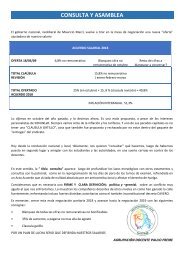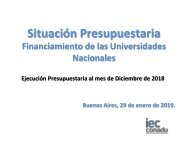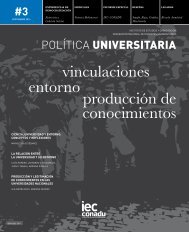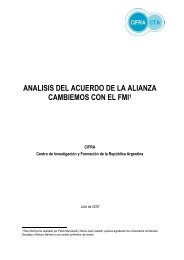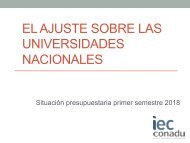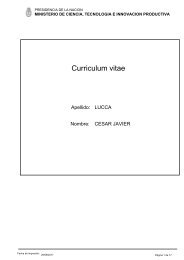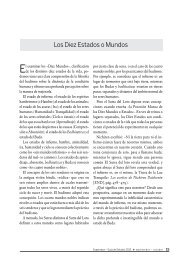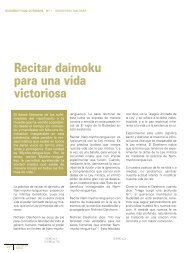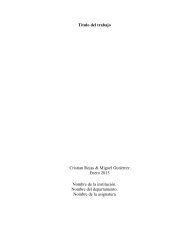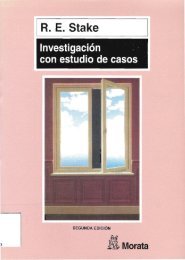- Page 2 and 3:
Metodologia de la investigaci6n Cua
- Page 4 and 5:
Dedicatoria Queremos agradeeer a la
- Page 6 and 7:
Reconocimientos Agradcccrnos a los
- Page 8 and 9:
IIJtCOIOCDIIIIlITOS xi Universidad
- Page 10 and 11:
ncollOCIllDllTOS xiii Benemirita Un
- Page 12 and 13:
UCOlrOClK1D1V8 xv Luis Guillermo Mu
- Page 14 and 15:
UCO.OCDIIDTOlI xvii Frinee Salazar
- Page 16 and 17:
Contenido Sabre los autores .......
- Page 18 and 19:
WilDiDO xxi lEn una investigaci6n s
- Page 20 and 21:
COlilDWO xxiii lCuales son los paso
- Page 22 and 23:
COllftllIDO La recolecci6n de los d
- Page 24 and 25:
Tablas y figuras . . . . .. - Figur
- Page 26 and 27:
AIIL&S Y PlGllUS xxix Figura 9.24 E
- Page 28 and 29:
TAIILAS Y nCllJUll xxxi Figura 15.8
- Page 30 and 31:
TABLAS Y nGlIlWI :xxxiii Tabla 10.1
- Page 32 and 33:
Sobre los antores Roberto Hernandez
- Page 34 and 35:
I Pr61ogo Metodologia de la investi
- Page 36 and 37:
n6LOOO xxxix ejemplos de nuestro ai
- Page 38 and 39:
CAPITULO 8 -3.,;.,,,,.11.- _+,;.111
- Page 40 and 41:
PROLOGO xliii • Ejemplos desarrol
- Page 42 and 43:
Primera parte • ... '" 0 Los enfo
- Page 44 and 45:
Capitulo • • • Similitudes y
- Page 46 and 47:
CAP1TuLo 1 Similitudes y diferenc:i
- Page 48 and 49:
CAPITuLo 1 SImilitudes y diferencia
- Page 50 and 51:
CAPfTuLo 1 Similitudes y d:iferenci
- Page 52 and 53:
CAPITuLo 1 SimllitudN y dlfereDciaa
- Page 54 and 55:
CAPITtJLo 1 _ y dilerenciao entre l
- Page 56 and 57:
CAPtroLo 1 Similitudes y diferencia
- Page 58 and 59:
CAPfTm.o 1 Similitudes y diferenc:i
- Page 60 and 61:
CAPtrm.o 1 Similitudes y dlIeIonciu
- Page 62 and 63:
CAPITuLo 1 Similitude. y diferencia
- Page 64 and 65:
CAPtroLo 1 Similitude. y cliferenci
- Page 66 and 67:
CAPtruLo 1 Similitudes Y diferencW
- Page 68 and 69:
CAPtruI.o 1 Similitudes Y di/..."ci
- Page 70 and 71:
CAP1TDLo 1 Similitudes y diferencia
- Page 72 and 73:
Fuentes. ;on Experiencias Materiale
- Page 74 and 75:
34 PRIMERA PARTE Los enfoques cuant
- Page 76 and 77:
36 PlIDIBIIA PARTZ Los eDfoques coa
- Page 78 and 79:
38 PRIIIUA PAIlTB Loo ODIoques C11A
- Page 80 and 81:
40 PRDIIIRA PAIlTlI Loa eufoq ... C
- Page 82 and 83:
42 PItIIIDA PAItTB Loo ellfoq .....
- Page 84 and 85:
Objetivos ~ -------"-1 GUlas del es
- Page 86 and 87:
46 SEGUNDA PARTE El proceso de la i
- Page 88 and 89:
48 SBGmmA PAllTlt El proceao deJa i
- Page 90 and 91:
50 SEGUlIDA PAlt'III El proeelO de
- Page 92 and 93:
52 UCllJIIDA PAHB K1 proceso de la
- Page 94 and 95:
54 SBGUllDA PARTE EI proceso deJa i
- Page 96 and 97:
56 SIICIUllDA PARTB Bl prote ••
- Page 98 and 99:
58 ueUlmA. PAllTE El proceso de 1a
- Page 100 and 101:
60 SllGlllIllA PAIt'm EI proceao de
- Page 102 and 103:
d;a t~rcera etapa la Inv~stigaci6n
- Page 104 and 105:
64 • • • ••• SBGUBDA PA
- Page 106 and 107:
66 SBGUlIDA PARTE E1 praceso de ]a
- Page 108 and 109:
68 SBGlllIDA PARTB BI proceso de 1&
- Page 110 and 111:
70 SBG1IlIDA PAHZ EI proceao de 1&
- Page 112 and 113:
cionan una idea de los temas inclui
- Page 114 and 115:
74 SBGIlIIDA PARTB Bl proceao de II
- Page 116 and 117:
76 SllGUlIDA PAlITII Elproceeo de l
- Page 118 and 119:
78 SEGtJlO)A PAHK El proceso de la
- Page 120 and 121:
80 SBGUlIDA PAlITII El proceao de 1
- Page 122 and 123:
82 SBGUlIDA P.un E1 proceso deJa in
- Page 124 and 125:
84 SBGUJ/DA PAllTB E1 proceso de Ia
- Page 126 and 127:
86 SEGUlIDA PAllTE El proceao de 1a
- Page 128 and 129:
88 SBGDlIDA PAllTlt E1 procell. de
- Page 130 and 131:
90 S&GUIlDA PARTE El proceso de la
- Page 132 and 133:
9Z SBGmmA PAlmI El_ do la in ... ti
- Page 134 and 135:
94 SKG1llIDA PARTE El_ de Ia ilmoot
- Page 136 and 137:
96 SBGUllDA pAllft El proceao de 1a
- Page 138 and 139:
Exploratorios -----+- Investigan pr
- Page 140 and 141:
100 SllGmmA PAJlTl! m procelO de 14
- Page 142 and 143:
102 SBGUlIDA PAIlTII El prooetO de
- Page 144 and 145:
Otros ejemplos de estudios descript
- Page 146 and 147:
106 UGUllDA PARTE Bl proceso de 1a
- Page 148 and 149:
108 SBGUIIDA PAllTII Bl proceao de
- Page 150 and 151:
110 SllGUlIDA PAlITII El_ de IA iDv
- Page 152 and 153:
112 SEGUNDA PARTE EI proceso de la
- Page 154 and 155:
114 SllGlJDA PAHII III proceso de 1
- Page 156 and 157:
• En ocasiones, al desarrollar nn
- Page 158 and 159:
118 SBG1JlIDA PAIl'III EI plOCe80 d
- Page 160 and 161:
Capitulo • • f • • • Form
- Page 162 and 163:
CAPiTULO 6 Formulacion de hip6tesis
- Page 164 and 165:
CAPtrm.o 6 Formulaci6n de bip6teaia
- Page 166 and 167:
CAPfTuLo 6 FormuJ.acion de bipotesi
- Page 168 and 169:
CAPtrm.o 6 FOIlIlulaci6D de bip6teo
- Page 170 and 171:
CAPtroLo 6 FormuJaci6D de blp6tesia
- Page 172 and 173:
CAPtrm.o 6 Formulad6n de h!p6teoie
- Page 174 and 175:
CAPtroLo 6 Formulaci6n de hip6teaia
- Page 176 and 177:
CAPITuLo 6 Formulaclde de hlp6teaia
- Page 178 and 179:
CAPtrIII.o 6 FOI1Ilulaci6Dde hip6te
- Page 180 and 181:
CAPiTULO 6 Formulacion de hipotesis
- Page 182 and 183:
CAPiTULO 6 Formulacion de hipotesis
- Page 184 and 185:
CAPtTULO 6 Formulaciiin de hipiites
- Page 186 and 187:
CAPtroLo 6 Formalaci6u do bip6tAaia
- Page 188 and 189:
Algunas variables no requieren que
- Page 190 and 191:
• Puesto que las hipotesis nulas
- Page 192 and 193:
CAPITuLo 6 Formulacl6n de hip6teoia
- Page 194 and 195:
Responder preguntas de investigaci6
- Page 196 and 197:
158 ••• SBOUllDA PAllTII Bl p
- Page 198 and 199:
Causa (variable independiente) Efec
- Page 200 and 201:
En un experimento, para que una var
- Page 202 and 203:
Moda1idades de manipulacion en Inga
- Page 204 and 205:
Despues, todos los participantes fu
- Page 206 and 207:
168 ••• ••• SBliUllDA P
- Page 208 and 209:
170 U61l11DA PAK'III E1_ de Ia mwat
- Page 210 and 211:
172 SBGlIlIDA PAllTlt El_ de 1& inv
- Page 212 and 213:
segmentos(en el ejemplo, estudiante
- Page 214 and 215:
176 SllGIllIDA PAlmI Elproceoo deJa
- Page 216 and 217:
178 SllGIJIIDA. pAllft Bl_ de la im
- Page 218 and 219:
180 SIIOUlIDA PAllTII El proceso de
- Page 220 and 221:
182 SllG1IlIDA PARD El proceao do]a
- Page 222 and 223:
184 UGUBDA PARTII B1 proc:eao de 14
- Page 224 and 225:
186 SBG1JBDAPAHII ElproceaodeJa~_ L
- Page 226 and 227:
-_. podrlan ocurrir otros acontecim
- Page 228 and 229:
190 UGUlIDA PAllTlt El_ de]a imoeti
- Page 230 and 231:
Se ha instruido a tres supervisores
- Page 232 and 233:
194 SllG1llIDA. P.t.IlTB I!lproceao
- Page 234 and 235:
196 SlIGmmA PAIlTB Elproceoo de 1a
- Page 236 and 237:
con que esti f1\bric1\do (supongamo
- Page 238 and 239:
En torno a esta fuente. Mertens (20
- Page 240 and 241:
202 SEGUNDA PARTE El proceso de la
- Page 242 and 243:
204 SEGUlfDA PARTE El proceso de la
- Page 244 and 245:
control directo sobre dichas variab
- Page 246 and 247:
Z08 ••• SBGIJlIDA. PAll1'II 8
- Page 248 and 249:
210 SBGllIIDA PARTB E1_ de 1a-.upci
- Page 250 and 251:
QESCRIPTIVOS Se recolectan datos y
- Page 252 and 253:
214 SBGUllDA PAlt'R ElptOCeIO de Lt
- Page 254 and 255:
Z 16 S11t11IlIDA PAItTB Rlproceao d
- Page 256 and 257:
EJEMPlO Analizar la manera en qne e
- Page 258 and 259:
220 SBG1IIIDAPARTII mproceao de lAi
- Page 260 and 261:
222 • • • SBGUlIDA PAlITII El
- Page 262 and 263:
La realidad .es que los estudios de
- Page 264 and 265:
• Logr'ar 1a validez intema es el
- Page 266 and 267:
ZZ8 SBGUlIDA PAIITII El proceoo de
- Page 268 and 269:
230 SBG1JlIDA PAIlTB Kl_ de 1a invu
- Page 270 and 271:
De aCUerdo con 10 anterior, se requ
- Page 272 and 273:
Capitulo • • • • • Selecc
- Page 274 and 275:
CAPtTm.o 8 Selecci6n de 1a muestra
- Page 276 and 277:
CAPfTm.o 8 Selecci6n de la muestra
- Page 278 and 279:
CAPtruLo 8 Selecci6n de la muestra
- Page 280 and 281:
CAPiTULO 8 Selecci6n de la muestra
- Page 282 and 283:
C&P1Tm.o 8 Seleccion de la muestra
- Page 284 and 285:
CAPfruI.o 8 Selecci6n de la muestra
- Page 286 and 287:
CA.P1Tm.o • Selecci6n de la muest
- Page 288 and 289:
CAP1Tm.o 8 Selecci6n de la muestra
- Page 290 and 291:
CAP1Tm.o 8 Seleccion de 1a muestra
- Page 292 and 293:
CAP1Tm.o 8 Selecci6n de la muestra
- Page 294 and 295:
CAP1ToLo 8 Selecci6n de la muestra
- Page 296 and 297:
- --------------- CAPiTULO 8 Selecc
- Page 298 and 299:
CAPtrm..o 8 Seleccion de la muestra
- Page 300 and 301:
CAP1TuLo 8 Sele~ci6n de la muestra
- Page 302 and 303:
C&PfTuto 8 Selecci6n de la muestra
- Page 304 and 305:
CAP1ToLo 8 Selecti6n de la muestra
- Page 306 and 307:
CAPfTtrLo 8 Seleccion de la muestra
- Page 308 and 309:
Medir variables 0 conceptos implica
- Page 310 and 311:
274 SEGUNDA PARTE El proceso de 1a
- Page 312 and 313:
Z 7 6 SBGllBDA PAlITII Bl proce •
- Page 314 and 315:
278 SBGUlIDA PAK'B E1 procell. de 1
- Page 316 and 317:
280 UGmmA PAItTII El proceso de 1a
- Page 318 and 319:
282 SBG1llIDA PAIlTII El p ...... d
- Page 320 and 321:
284 SBGUIIDA PAllTlI Elproceoo de 1
- Page 322 and 323:
286 SllGUlIDA PAIlTB R1 proceso de
- Page 324 and 325:
288 SEGUlfDA PARTE El proceso de la
- Page 326 and 327:
290 SBGUllDA PAllTB El pr0ce80 de I
- Page 328 and 329:
292 SEGtnmA PARTE EI proceso de la
- Page 330 and 331:
294 UGUlIDA PARTlI El proceao de Ia
- Page 332 and 333:
296 SBGU\lDA PAHiI B1 proceao de]a
- Page 334 and 335:
298 SBGlllIllA PAllTlI El proceao d
- Page 336 and 337:
300 SBGIlIIDA PAIlTB BI proceao de
- Page 338 and 339:
302 SBGUllDA PAltTlt Elproceoo de l
- Page 340 and 341:
304 SlI0UllDA PAllTlt El pn>c:eSO d
- Page 342 and 343:
306 SBGlIlIDA PAllTII Blproceeo de
- Page 344 and 345:
308 SBGUlIDA PAltTB E1proceeo de la
- Page 346 and 347:
310 SllGlIBDA PAIlTB ElprocelO de I
- Page 348 and 349:
312 UCIUIIDA PAIlTB E1 proceao de I
- Page 350 and 351:
314 SltGlJIIDA PAIITB El proceso de
- Page 352 and 353:
Las pregun(as abiertas proporcionan
- Page 354 and 355:
318 SBGUlIDA PAltTB El procell. de
- Page 356 and 357:
320 Sl!GUlmA PAltTlt El proceoo de
- Page 358 and 359:
322 UtlIlllDA PART!! E1_ de]a imuti
- Page 360 and 361:
324 SllGUllDA PAllTB E1 proceao de
- Page 362 and 363:
EJEMPLO Instrucciones de un cuestio
- Page 364 and 365:
328 SBGIllIDA PAllTII El p ...... d
- Page 366 and 367:
330 SllGlJIIDA PAIlTB El proceao de
- Page 368 and 369:
332 SBGlIlmA PAIlTB E1 proceIo deJa
- Page 370 and 371:
334 SItGUlIDA PAIlD EI proce8O deJa
- Page 372 and 373:
336 SIIGmmA PAIlTlI El procelO de 1
- Page 374 and 375:
4. Entre la carta previa y la comnn
- Page 376 and 377:
340 SEGUlfDA PARTE El proceso de la
- Page 378 and 379:
34Z UG1IlIDA PAItD 111 proceoo de ]
- Page 380 and 381:
344 SBGUlIDA PAHII El p ...... de 1
- Page 382 and 383:
346 SBGUllDA PAID Elproceoo de 1a i
- Page 384 and 385:
348 SIIG1J1Q)A PAIlTB El proceso d.
- Page 386 and 387:
350 SKGmmA PAlITlI El proceoo de IA
- Page 388 and 389:
352 SEGUNDA PARTE El proceso de la
- Page 390 and 391:
354 SEGUNDA PARTE El proceso de 1a
- Page 392 and 393:
356 SFGUNDA PARTE El proceso de la
- Page 394 and 395:
358 SEGUNDA PARTE E1 proceso de la
- Page 396 and 397:
360 SEGUNDA PARTE El proceso de la
- Page 398 and 399:
362 SEGUNDA PARTE EI proceso de la
- Page 400 and 401:
364 SEGUNDA PARTE EI proceso de la
- Page 402 and 403:
366 SEGUNDA PARTE El proceso de la
- Page 404 and 405:
368 SEGUNDA PARTE El proceso de la
- Page 406 and 407:
, 370 SEGUIfDA PARTE El proceso de
- Page 408 and 409:
372 SEGUNDA PARTE EI proceso de la
- Page 410 and 411:
374 SEGUNDA PAlttE El proceso de 1a
- Page 412 and 413:
376 SEGUNDA PARTE El proceso de 14
- Page 414 and 415:
378 SEGUNDA PARTE EI proceso de 14
- Page 416 and 417:
380 SEGUNDA PARTE El proceso de la
- Page 418 and 419:
382 SEGUlfDA PARTE El proceso de la
- Page 420 and 421:
384 SEGUNDA PARTE El proceso de la
- Page 422 and 423:
386 SEGUNDA PARTE El proceso de la
- Page 424 and 425:
388 SEGUNDA PARTE El pmceso de la i
- Page 426 and 427:
390 SEGUNDA PARTE El proceso de 1a
- Page 428 and 429:
392 SEGUNDA PARTE El proceso de La
- Page 430 and 431:
394 SEGUNDA PARTE EI proceso de la
- Page 432 and 433:
396 SEGUlIDA PARTE EI proceso de la
- Page 434 and 435:
:198 SEGUNDA PARTE El proceso de la
- Page 436 and 437:
400 SEGUNDA PARTE EI proceso de la
- Page 438 and 439:
402 SEGUlIDA PARTE El proceao de 1A
- Page 440 and 441:
404 SBGlJlO)A. PARTB El procell. de
- Page 442 and 443:
SPSS Programas computacionales SAS
- Page 444 and 445:
408 ..- SBGUlIDA PARTB E1 proee80 d
- Page 446 and 447:
410 SBGlJIIDA PAlITB E1 proce8O de
- Page 448 and 449:
412 SEGUlIDA PARTlt E1 proce ••
- Page 450 and 451:
414 SEGUNDA PARTE EI proceso de la
- Page 452 and 453:
416 SBGUlIDA PAllTlI El p ...... de
- Page 454 and 455:
418 UG1IlIDA PAllTE &I proceao de]a
- Page 456 and 457:
420 SBGUlIDA PAllTE E1 proce8o deJa
- Page 458 and 459:
Tabla 10.7 Ejemplo de una distribuc
- Page 460 and 461:
424 SEGUlIDA P.A.RTB E1 proceso de
- Page 462 and 463:
426 SBGlJlIDA pAJtTII 111 proceao d
- Page 464 and 465:
428 SBGUlIDA PAIlTB El proces. de 1
- Page 466 and 467:
En cambio, si los resnltados fueran
- Page 468 and 469:
432 SllGUlIDA PAIlTB E1 proceso de]
- Page 470 and 471:
434 UOlJlll)A pAltft El proceao de]
- Page 472 and 473:
436 SEG1I1IDA PAIlTB EI proceso de
- Page 474 and 475:
438 SBG1IIIDA PAIlTE El proceso de
- Page 476 and 477:
440 SEGUlIDA PAllTlt Elprvceoo delA
- Page 478 and 479:
442 SllGUlIDA PAllTlt El proceao de
- Page 480 and 481:
444 SllGllBDA PAKTII EI proceso de
- Page 482 and 483:
446 UGlIlIDA PAIlTB &I proceao do ]
- Page 484 and 485:
448 SltGUlIDA PAIlTB EI proceso de
- Page 486 and 487:
450 SllGUBDA PAITII E1 proceeo de I
- Page 488 and 489:
452 SlIGmmA PAllTE El proce ••
- Page 490 and 491:
454 SllGmmA PAR'll! El P"""''' de I
- Page 492 and 493:
456 UG1JIIDA pAllft K1 proceoo de ]
- Page 494 and 495:
458 UGUlIDA PAItTII I!l proceao de
- Page 496 and 497:
460 SBGIJJIllA PAllTlI El_ de ]a iD
- Page 498 and 499:
46Z SBGUlIDA PAlITII E\ procelO de
- Page 500 and 501:
464 SBOUlIDA PAllTB E1 proceao de 1
- Page 502 and 503:
466 UGUlIDA PAHZ B1_ do ]a iIln0tip
- Page 504 and 505:
468 SBGllJIDA PAJlTlI Bl proceso de
- Page 506 and 507:
470 SIIGUllDA pAIlT£ E1 proceao de
- Page 508 and 509:
472 SllG1JIIDA PAII'B El_ do]a ilmo
- Page 510 and 511:
474 SBG1lIIDA PARTII B1 proceoo de
- Page 512 and 513:
476 SBGlJIIDA PAItTII E1 procell. d
- Page 514 and 515:
478 SBGmmA PAllU El_ de .. iJmatiga
- Page 516 and 517:
480 SJtGmmA PAHII EI proceao de Ia
- Page 518 and 519:
482 U01JIDA PARU l!l_ de 1& imeatip
- Page 520 and 521:
484 SEG1JlIDA PAllTlt E1 proceeo de
- Page 522 and 523:
486 SBGUlIDA PAItTE E1 proceao de 1
- Page 524 and 525:
488 IIBGUlIDA PAllTB E1pn1CUO deJa
- Page 526 and 527:
490 SBGUIIJ)A PAlmI BI proce .. de
- Page 528 and 529:
492 SBQOlIDA PAlITII E1 proceao d.1
- Page 530 and 531:
494 UG1JIIDA PAllft m _ de .. m-tIp
- Page 532 and 533:
496 SBGUlIDA PAllTII EI proceoo del
- Page 534 and 535:
498 SBGUlIDA PARD El_ de ]a iJI...t
- Page 536 and 537:
10 REPORTE DE RESULTADOS DEL PROCES
- Page 538 and 539:
502 SEGUNDA PARTE EI proceso de la
- Page 540 and 541:
504 SlIQlJlIDA PAlITII Bl proceao d
- Page 542 and 543:
506 SBGUlIDA PAllTB BI proce ••
- Page 544 and 545:
508 SBGlIIIDA PAR'lII Elproeeao do]
- Page 546 and 547:
510 UOlJllDAPAllft lIlproceoodelail
- Page 548 and 549:
512 SBGUlIJ)A. PAm"E El proceso de
- Page 550 and 551:
514 SllGUliDA PAIlTII E1 proceao de
- Page 552 and 553:
516 SllGUlIDA PAlITII I!l procell.
- Page 554 and 555:
2.1.· Confiabilidad de toda la esc
- Page 556 and 557:
Tercera parte . . . . ,. EI proceso
- Page 558 and 559:
Capitulo • • • • El inicio
- Page 560 and 561:
CAPtrUI.o 12 E1 inicio del proceso
- Page 562 and 563:
CAPlTm.o 12 E1 inicio del proceso c
- Page 564 and 565:
CAPlTuLo 12 E1 inicio del proceso c
- Page 566 and 567:
CAPiTULO 1.2 El inicio del proceso
- Page 568 and 569:
CAPiTULO 12 El inicio del proceso c
- Page 570 and 571:
CAPfTDto 12 El inicio del proceso c
- Page 572 and 573:
CAPfTULO 12 El inicio del proceso c
- Page 574 and 575:
CAPtroLo 12 El inicio del proceso c
- Page 576 and 577:
CAP1TuLo 12 El inicio del proceso c
- Page 578 and 579:
CAPfruLo 12 EI inicio del proceso c
- Page 580 and 581:
CAP1TuLo 12 El inicio del proceso c
- Page 582 and 583:
CAPtrm.o 13 El inicio del proceso c
- Page 584 and 585:
CAPtTULO 12 El inicio del proceso c
- Page 586 and 587:
CAPtruLo 12 El inicio del proceso c
- Page 588 and 589:
C&PfTuLo 12 E1 inicio del proceso c
- Page 590 and 591:
CAP1Tm.o 12 El inicio del proceso c
- Page 592 and 593:
C&PtruLo 12 E1 inicio -del proce~o
- Page 594 and 595:
Durante a despues de la inmersi6n i
- Page 596 and 597:
562 TERCERA PARTE El proceso de la
- Page 598 and 599:
Cabe destacar, que los tipos de est
- Page 600 and 601:
566 TBaCUA P.umI El P"""''' de II.
- Page 602 and 603:
568 TBRCBllA PARTB EI proceao deJa
- Page 604 and 605:
570 TBIlCKllA pAJlTB E1_ dela in ..
- Page 606 and 607:
572 TERCERA PARTE El proceso de la
- Page 608 and 609:
574 TUCBllAPAlmI mp ...... delainve
- Page 610 and 611:
576 TIIRCltIlA PAlt'I\I E1 proce8O
- Page 612 and 613:
Tipo de inuestra: participantes vol
- Page 614 and 615:
Capitulo Recoleccion y anilisis de
- Page 616 and 617:
CAPiTULO 14 Recoleccion y an.ilisis
- Page 618 and 619:
CAPiTULO 14 Recolecci6n y anilisis
- Page 620 and 621:
CAPtTULO 14 Recolecci6n y an.iI:isi
- Page 622 and 623:
CAPtrm.o 14 Recolecci6n yanruisis d
- Page 624 and 625:
CAPtrm.o 14 Recoleccion y anilisis
- Page 626 and 627:
CI.Pf.TULo 14 Recoleccion y amilisi
- Page 628 and 629:
CAPtroLo 14. Recolecci6n y anatisis
- Page 630 and 631:
CAPfTULO 14 Recolecci6n y anruisis
- Page 632 and 633:
CAP:fTuLo 14 Recoleccion y amilisis
- Page 634 and 635:
CAP1TDLo 14 Recoleccion y an.ilisis
- Page 636 and 637:
CAP1Tm.o 14 Recolecci6n y an.ilisis
- Page 638 and 639:
CAPiTULO 14 Recoleccicin y anruisis
- Page 640 and 641:
CAPtnrLo 14 Recolecci6n y anilisis
- Page 642 and 643:
CAPiTuLo 14 Recolecci6n y aruilisis
- Page 644 and 645:
CAPfTuLo 14 Recolecci6n y amilisis
- Page 646 and 647:
CAPtrm.o 1. Recolecci6n y anilisis
- Page 648 and 649:
CAPfTDLo 14: Recolecci6n y anilisis
- Page 650 and 651:
CAPtruLo 14 Recolecci6n y amilisis
- Page 652 and 653:
CAPiTULO 14 Recoleccion y amilisis
- Page 654 and 655:
CAPtrm.o 14 Recolecci6n y amilisis
- Page 656 and 657:
CAPiTULO 14 Recoleccion y aruilisis
- Page 658 and 659:
C&PfTm.o 1" Recoleccion y anilisis
- Page 660 and 661:
CAP1Tm.o 14 Recoleccion y an.ilisis
- Page 662 and 663:
CAPtruI.o 14 Recoleccion y aruilisi
- Page 664 and 665:
CAP1ToLo 14 Recolecci6n y analisis
- Page 666 and 667:
CAP1Tm.o 14 Recolecci6n y anAlisis
- Page 668 and 669:
CAP1TuLo 14. Recolecci6n y an.ilisi
- Page 670 and 671:
C&Ptrm.o 1" Recoleccion y analisis
- Page 672 and 673:
CAPtruLo 14 Recoleccion y an.ilisis
- Page 674 and 675:
C&Ptrm.o 14 Recolecci6n y anaJisis
- Page 676 and 677:
CAP1TuLo 14 Recoleccion y anruisis
- Page 678 and 679:
CAPtrUI.o 14 Recoleccion y anilisis
- Page 680 and 681:
CAPfTuLo 14 Recolecci6n y amilisis
- Page 682 and 683:
CAPtruLo 14 Recoleccion yanaJisis d
- Page 684 and 685:
CAPtnJLo 1" Recoleccion y anilisis
- Page 686 and 687:
C&P1Tm.o 14: Recoleccion y anilisis
- Page 688 and 689:
CAP1TuLo 14 Recoleccion y amilisis
- Page 690 and 691:
CAPtruLo 14 Recolecci6n y anaJ.isis
- Page 692 and 693:
CAPfTuLo 14 Recoleccion y amilisis
- Page 694 and 695:
CAP1TULO 14 Recoleccion y amilisis
- Page 696 and 697:
CAP1ToLo 14 Recolecci6n y a.n.ilisi
- Page 698 and 699:
C&P1ToLo 14 Recolecci6n y anilisis
- Page 700 and 701:
CAPtruLo 14 Recolecci6n y anilisis
- Page 702 and 703:
CAPiTULO 14 Recoleccion y anilisis
- Page 704 and 705:
CAP1TuJ.o 14 Recoleccion y an.ilisi
- Page 706 and 707:
CAPiTuLo 14 Recolecci6n y aruilisis
- Page 708 and 709:
CAP1TtJLo 14 Recoleccion y a.n.ilis
- Page 710 and 711:
CAPfTuLo 14 Recolecci6n y an8.lisis
- Page 712 and 713:
CAP1TuLo 14 Recoleccion y an.ilisis
- Page 714 and 715:
C.&Ptrm..o 14 Recoleccion y an;i\.i
- Page 716 and 717:
CAP1Tm.o 14 Recoleccion y amilisis
- Page 718 and 719:
.~ Capitulo Diseios del proceso de
- Page 720 and 721:
CAPiTULO 15 Diseiios del proceso de
- Page 722 and 723:
CAPtrm.o 15 Disefios del proceso de
- Page 724 and 725:
CAPfrm.o 15 Diseiios del proceso de
- Page 726 and 727:
CAPtrm.o 15 Diseiios del proceso de
- Page 728 and 729:
CAPfTm.o 15 Diseiios del proceso de
- Page 730 and 731:
- Disefios etnogrcificos CAPiTULO 1
- Page 732 and 733:
CAPlTDLo 15 Disenos de] proceso de
- Page 734 and 735:
CAPiTULO 15 Diseiios del proceso de
- Page 736 and 737:
CAPtTm.o 15 Disenos del proceso de
- Page 738 and 739:
CAP1TuLo 15 Disefios del proceso de
- Page 740 and 741:
CAPfTot.o 15 Diseiios del proceso d
- Page 742 and 743:
C&Ptrm..o 15 Disenos del proceso de
- Page 744 and 745:
CAPfTuI.o 15 Disenos del proceso de
- Page 746 and 747:
CAPfTULO 15 Disefios del proceso de
- Page 748 and 749:
CAP1Tuto 15 Diseiios del proceso de
- Page 750 and 751:
CAPtrm.o 15 Diseiios del proceso de
- Page 752 and 753:
~ l.~ 1)lsenos ilel. proceso (Ie -r
- Page 754 and 755:
Capitulo EI reporte de resultados d
- Page 756 and 757:
. CAPiTULO 16 EI reporte de resulta
- Page 758 and 759:
CAPfTULO 16 El reporte de resultado
- Page 760 and 761:
CAP1TDLo 16 El reporte de resultado
- Page 762 and 763:
CAP1ToLo 16 El reporte de resultado
- Page 764 and 765:
CAPtrm.o 16 El reporte de resultado
- Page 766 and 767:
CAP1Tm.o 16 El reporte de resultado
- Page 768 and 769:
CAPtruto 16 E1 reporte de resultado
- Page 770 and 771:
CAPtrm.o 16 EI reporte de resultado
- Page 772 and 773:
CAP1Tm.o 16 El reporte de resultado
- Page 774 and 775:
CAPtTULO 16 El reporte de resultado
- Page 776 and 777: CAPtrm.o 16 El reporte de resultado
- Page 778 and 779: CAPtrm.o 16 El reporte de resultado
- Page 780 and 781: CAPtroLo 16 El reporte de resultado
- Page 782 and 783: Recolecci6n Datos cuantitativos y c
- Page 784 and 785: 752 -_. CUARTA PARTE Los procesos m
- Page 786 and 787: 754 CUAHA PAIl'B Los proceaoa _ de
- Page 788 and 789: 756 CUAllTA P.6ll'IB Loa proceaoa _
- Page 790 and 791: 758 CUARTA PARTE Los procesos mixto
- Page 792 and 793: 760 CUAKTA pAllft Loa __ mlztoa de
- Page 794 and 795: La edad de los hijos e hijas fue en
- Page 796 and 797: • No han demostrado tener capacid
- Page 798 and 799: 766 CUAll'U PAllTB !-
- Page 800 and 801: 768 CUAllTA PllTII ':"" proceaoa mi
- Page 802 and 803: 770 CUAIt'U PARTII Loa ___ de iDvoo
- Page 804 and 805: 772 ClJAllTA PARTII 1.0, plOCooo,..
- Page 806 and 807: 774 CUAllTA PAIlTB Loa proceoos _ d
- Page 808 and 809: EJEMPL0 13 Estudio de la imagen ext
- Page 810 and 811: 778 CUAllTA PAll'B 19' proce ... mi
- Page 812 and 813: 780 ClIAR'U. PAltTB i.?' proceeo. _
- Page 814 and 815: 782 CUAKTA PAllTK r:oa proceaoa miz
- Page 816 and 817: 784 CUARTA PARTE ~os procesos minos
- Page 818 and 819: 786 CUAllTA PAlmI Lo. proceooo _ de
- Page 820 and 821: 788 CUARTA PARTE Los procesos minos
- Page 822 and 823: 790 CUAItTA PAlITB Loa proceaoo _ d
- Page 824 and 825: 792 CDAllTA PAIlTB Loa procesoemixt
- Page 828 and 829: 796 CUARTA PARTE ~os procesos mixto
- Page 830 and 831: 798 CUAllTA PAlmI 1:"& procell" mmo
- Page 832 and 833: 800 CUARTA PAIITK ':"' proceaoa min
- Page 834 and 835: 802 CUAllTA PAIlTB !-"' proceIIoa _
- Page 836 and 837: 804 CUAllTA PARTII i:"' proceao8 _
- Page 838 and 839: 806 CUAllTA PAIl'm Lo. proce ... ..
- Page 840 and 841: 808 cu.uu PARD I:"" proc:eIOO ..u.u
- Page 842 and 843: 810 BmLlOGR.UU. CONSECUENCIAS DEL A
- Page 844 and 845: 81Z , Baptista, P. (2002). EI medio
- Page 846 and 847: 814 BlBUOORAP1A , Coleman, H. Y Unr
- Page 848 and 849: 816 BmLloollDfA , Fernandez Collado
- Page 850 and 851: 818 BIBLIOORAFIA , Harre, R Y Cryst
- Page 852 and 853: 820 BlBLIOOJWiA Jordan, C., Frankli
- Page 854 and 855: 822 BlBLlOOum Markus, G. B. (1979).
- Page 856 and 857: 824 BIBLlOOIlAJ1.\ National Aeronau
- Page 858 and 859: 826 BIBLlOGRAJfA. Reckase, M. D. (1
- Page 860 and 861: 828 BIBUOORArlA Stake, R. (2000). C
- Page 862 and 863: 830 BIBLlOORAftA. Wiersma, W. (1999
- Page 864 and 865: 83Z bmlCII OIOIl!sTlCO Cameron, 780
- Page 866 and 867: 834 J Jackson, 730, 745, 746 Jaffe,
- Page 868 and 869: 836 s Salavarrieta, Duvan T., 519 S
- Page 870 and 871: {ndice analitico •••• - '*
- Page 872 and 873: i,' fimlCK A1JALtrIco 841 Diseiios
- Page 874 and 875: i,' IImIIZ ABALITIco 843 de laborat
- Page 876 and 877:
flDlCZ AIfALlTlco 845 justificacion
- Page 878 and 879:
847 I N Nivel de medici6n, 303-306
- Page 880 and 881:
InICB AlI'ALlTIco 849 Spearman, Rho




